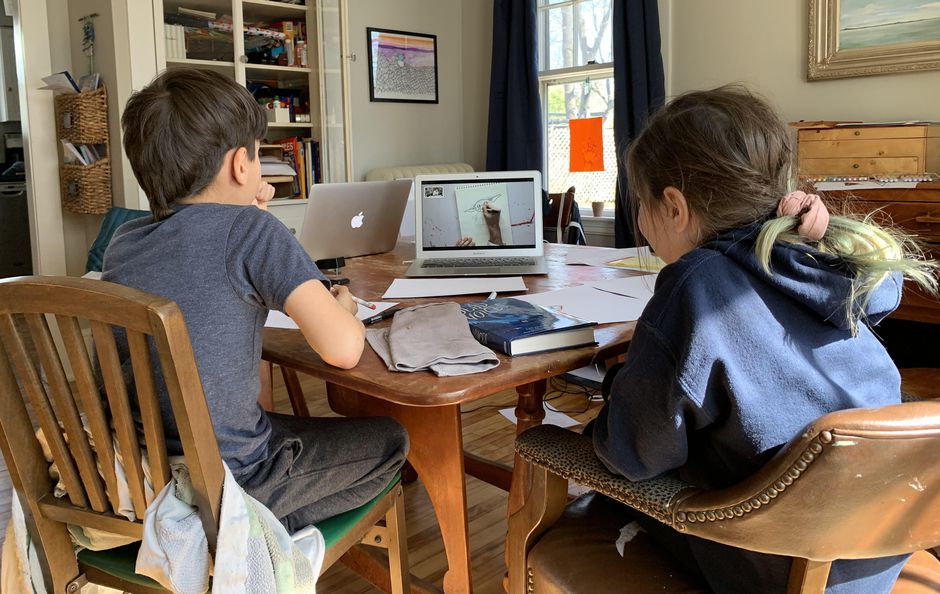
Here we sit, me and my first-grade daughter, doing another distance learning lesson. We are only two minutes into the first video when she starts dramatically rolling around all over the bed. As she twists and turns, visibly frustrated, it seriously looks like she is writhing around in agony. “Ugh! Moooooom, how much longer?” she complains. This is typical behavior for her at some point during these learning sessions. Her schedule consists of Monday through Thursday. Her lessons include: one reading lesson, one math lesson, and one writing lesson. Each lesson has several different tasks. She is also required to complete portions of her “specials” classes, which include music and physical education.
These lessons, on average, have taken about two hours a day. Honestly, I was not too thrilled on the first day of our distance learning experience when we had to suddenly launch into a twenty-minute workout after completing hours of academic lessons! Although she protests, (and she protests with all her might), I have been consistent in having her complete each portion of each lesson. Somehow, we have completed everything to date. Here is the trick I have been using: I sit by her side the whole time. I watch all the instructional videos with her, I answer her questions when she works through the activities, I set her up with her needed materials, and I even participate in the tiring PE workout videos with her. I realize I am not required to do all these things with her. But I would guess that kids, of any age, may not have the attention span or discipline to complete hours of assigned school work—especially when it may not be interesting to them.
I realize it is not possible for some parents to sit with their children during their homeschooling lessons. I realize some parents simply do not want to endure their children’s homeschooling material. I absolutely understand that; no judgment here. I realize some parents are asking their child’s older siblings to assist with their siblings’ learning tasks because they are unable to. I completely understand this, too. I also realize there are some kiddos who will not receive any assistance with homeschooling, whether it is intentional or unintentional. I sympathize with each one of these scenarios. We are not all equipped for homeschooling, for many reasons.
I can help my daughter with homeschooling due to a laundry list of privileges. The first privilege that should be noted is that we speak, read, and write in English. This is not the case for many of her classmates and their families. Although materials are translated for varied languages, this does not mean these families do not face language barriers. There is plenty of confusion that can happen when navigating the English language. “Have you ever been to a desert?” or “Don’t desert me!” Same spelling, different meanings. That is just one small example. Next, I am a stay-at-home mom. My husband works, and I stay home with the kids. I appreciate the ability to stay home during this pandemic more than I can tell you all. This ability has allowed me to assist in my daughter’s homeschooling with no time restrictions. I have a younger son that keeps me running too, but again: I am home full-time, so we can easily move things in our schedule around.
Another privilege is our access to technology. We are fortunate enough to have a beautiful laptop, consistent and unlimited internet service, and a quiet place to work. Many families in our school district have had to borrow Chromebooks from the school. I am incredibly glad that this opportunity exists, but that does not mean that students and their families know how to operate them. Beyond navigating the computer, the school portal is its own beast.
Lastly, I have professional experience in education: a master’s degree in education and lengthy experience with distance learning. My background has greatly enhanced my understanding of her school portal and its inner workings. For those who are less-equipped than our family, I can only imagine how frustrating this process is for you. I am sending you patience, strength, and a big, virtual hug.
Although the students are getting the same learning materials, the same technology, the same lessons, and the same teacher through their lessons, this process does not truly provide equity. I do not blame the school district. I do not blame the lesson plans or materials. I do not blame anything, or anyone. The situation is not the same for all students because each student has a different person at home who is facilitating their learning—assuming they have someone assisting in their new distance learning journey at all. It is important to consider who is helping each student at home (if anyone), and to consider that person’s experience and attitude toward education. I will guess that some guardians/homeschooling facilitators will let their child skip a lesson or two while others will not. I imagine some homeschooling facilitators can whiz through their child’s work, while some do not understand the content and simply cannot help. I imagine that some kids are trusted to do the work unsupervised and that work might not get done. I imagine that some students are not being encouraged to do lessons because their homeschool facilitators may believe that the students do not need to do the work, and they will “be fine” if they do not. Believe me: my daughter has whined this same sentence more times than I can count: “Come on…I already know this, mom!” about many of her instructional videos. My answer is always the same, “Harper, this work has been assigned to you. If you already know it, great! You will understand it even better after you watch this.” She rolls her eyes and scoffs at my mom-like remark, and we move along. I am making her sound like such a brat, sorry Harps! I promise you all: she is not. She is an absolute sweetheart; when she is making these objections, it is because she is frustrated with this “new normal” like most of us.
Again, no judgement to anyone, about anything. I am not saying at all that your children will “not be fine” if they do not do these lessons. I just want to relay that we will all make different choices during this process, and that is understandable. People are different, and the context that influences our actions and parental choices matters.
I know we have heard this again and again, but I will repeat the commonly used quarantine mantra: “we are in this together.” Each of our abilities are different. Our attitudes toward education are not the same as the next person’s. Parents are suddenly expected to teach in this situation, and I know that it is hard. Not to mention kids are suddenly expected to view their parent as a teacher, and I bet this is hard for them too! It is almost laughable. I wish I had magical tips or advice, but I do not. I know we are tired of hearing this too, but just “do your best”. When the kids are back in school, we can count on good ole’ fashioned assessments, and our superheroes: professionally trained teachers. Our hard-working, caring teachers will be there to help identify the students who have fallen behind developmentally. What we can do now to help the teachers for the student’s return to school—and the long road of catch-up ahead—is to try our absolute best to support our children’s learning at home to the best of our abilities.
Support will look different in each household. Support will depend on many factors, such as a guardian’s schedule, skill, and willingness. When you are able, sit with your children during their lessons. Even if you are uncomfortable or unsure about teaching, sit next to them as they wade through their work. To some kids, your mere presence can provide a sense of support and camaraderie. When you are stuck on your children’s schoolwork, beyond reaching out to the teacher, reach out to your friends and family who may be able to help. Recently, a friend posted on Facebook about her frustration with her daughter’s homework assignment. She was stuck on a specific question. I could not believe how quickly and how many people commented, trying to help her (I was one of them). Several of us spent hours going back and forth and researching until we found an answer. It was truly an “it takes a village to raise a child” moment.
For younger students, use silly examples that will gain your child’s attention during lessons. For older students, offer them a snack while they are working. Even throwing out a “Good job!” or “You’ve got this!” shout from down the hall may motivate them. Give your older siblings who are helping some type of healthy incentive and try to acknowledge their hard work too. Offer your homeschooler and their older sibling helpers “fun time” whatever that may be after their lessons are complete. Perhaps indulging in a new movie rental, ordering special takeout, or simply spending time with them doing what they would like to do. If money and time are limited, that is understandable. Try and build a free activity based on their interests. Research something interesting to do together, play a game, or take a walk somewhere.
Whatever your version of encouragement is, give it to them when you can. I would guess that this pandemic and its elements have been exhausting for many of us, whether we are young or old. Wishing you all good teaching, good learning, and lots of love.

Stephanie McCoy was born and raised in Portland, Oregon-where she still lives. She recently graduated with a Master’s in Education degree from Concordia University. In her free time: she likes to read and write, get outdoors, embrace her kiddos and husband, and watch travel documentaries.
2 thoughts on “Homeschooling – Are We Equipped For This?”
Comments are closed.

What an insightful article! So many wonderful ideas while showing the personal struggle of so many families.